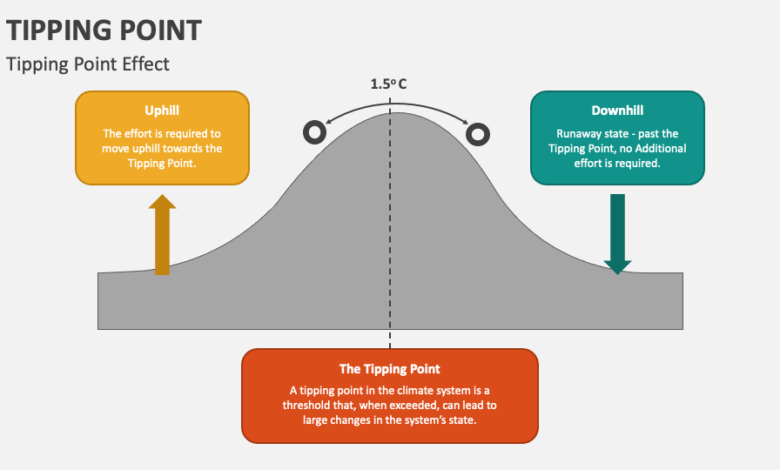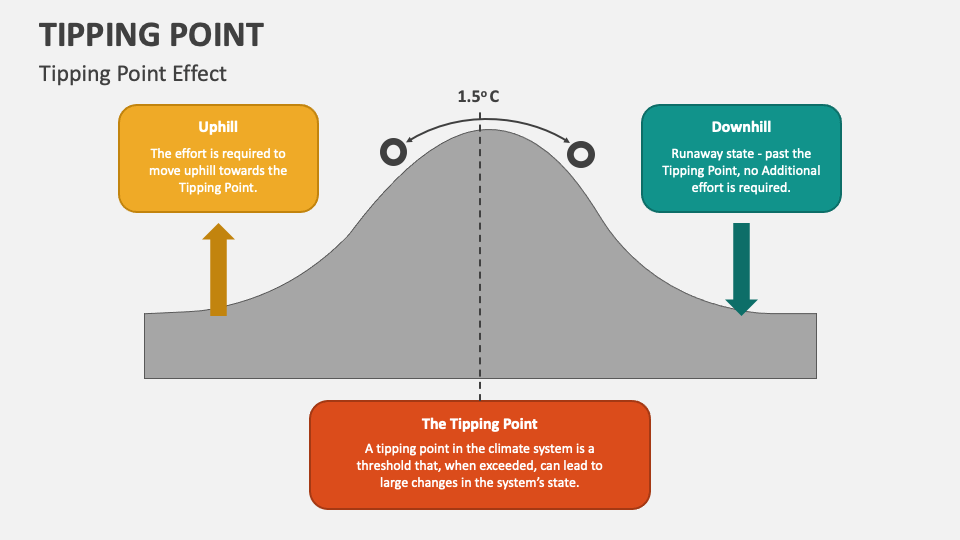
Are We Past the Tipping Point?
Are we past the tipping point? This question hangs heavy in the air, a looming concern for the future of our planet. From melting glaciers to social unrest, signs of a critical shift abound. This exploration delves into the complex issue of global tipping points, examining potential triggers, current conditions, and possible pathways forward.
The concept of a tipping point, often associated with environmental catastrophes, is not confined to the natural world. Social and economic systems also exhibit this dynamic behavior, where small changes can lead to dramatic, irreversible transformations. This article investigates the potential for interconnected tipping points across various domains and explores the intricate interplay between them.
Defining the Tipping Point
The concept of a tipping point, often used in discussions about global challenges, refers to a critical threshold beyond which a system undergoes a fundamental, often irreversible shift. It’s not just a gradual change, but a qualitative leap, a point of no return. This understanding is crucial in evaluating the potential consequences of our actions and predicting the trajectory of various systems, from ecosystems to economies.A tipping point isn’t a singular event, but rather a process characterized by a confluence of factors pushing a system past a critical threshold.
This threshold represents the point where the system’s inherent stability is overcome, leading to a cascade of changes that are often difficult to reverse. Understanding these thresholds is vital to anticipate and mitigate the potential for large-scale, disruptive shifts.
Characteristics of a Tipping Point
A tipping point is defined by several key characteristics. Firstly, it involves a threshold, a specific level or point beyond which the system’s behavior changes dramatically. Secondly, the changes resulting from reaching the tipping point are often irreversible, meaning the system will not return to its previous state without significant intervention. Finally, tipping points frequently involve feedback loops, where the initial change triggers a chain reaction, amplifying the impact and making the shift even more pronounced.
Types of Tipping Points
Understanding the various types of tipping points allows for a more nuanced approach to global challenges. Each type exhibits unique characteristics and triggers.
| Type of Tipping Point | Description | Example |
|---|---|---|
| Environmental | These relate to shifts in natural systems, often driven by climate change or human-induced pressures. | Melting of ice sheets, Amazon rainforest dieback, coral bleaching. |
| Social | These concern societal structures and behaviors, potentially leading to large-scale changes in political systems or cultural norms. | Mass migrations due to environmental disasters, social unrest leading to regime change. |
| Economic | These relate to shifts in economic systems, such as financial crises or the collapse of markets. | The 2008 global financial crisis, the collapse of empires. |
Thresholds and Irreversible Changes
Thresholds are critical points where small changes can lead to large and often unpredictable outcomes. For example, the melting of Arctic sea ice has crossed a threshold, resulting in a positive feedback loop that accelerates the melting process. The resulting changes, such as sea level rise and alterations in ocean currents, are difficult to reverse.
“A tipping point is not a single event, but rather a process of cascading changes that often become self-reinforcing.”
Identifying Potential Tipping Points: Are We Past The Tipping Point

The concept of tipping points, often used in climate science, describes a threshold beyond which a system undergoes a rapid and potentially irreversible shift. These transitions can occur in various domains, from the environment to social structures, and understanding their potential triggers is crucial for mitigating their impact. Identifying potential tipping points allows us to proactively address vulnerabilities and explore strategies for resilience.Identifying these points involves understanding the interconnectedness of complex systems and the delicate balances that exist within them.
A disruption in one area can cascade into unforeseen consequences across other sectors, highlighting the urgent need for a holistic approach to risk assessment.
Environmental Tipping Points
Understanding environmental tipping points is vital to comprehending the potential for catastrophic shifts in the Earth’s systems. These events can lead to irreversible changes with significant consequences for human societies and ecosystems. Forests, oceans, and ice sheets are examples of systems vulnerable to tipping points.
- Arctic Sea Ice Loss: The shrinking Arctic sea ice is a prime example of a potential tipping point. As the ice melts, the exposed ocean absorbs more solar radiation, accelerating the warming process. This positive feedback loop can lead to a rapid decline in sea ice, potentially triggering further climate change impacts, including rising sea levels and changes in ocean currents.
- Amazon Deforestation: The Amazon rainforest plays a critical role in global climate regulation. Massive deforestation releases significant amounts of stored carbon into the atmosphere, exacerbating climate change. Furthermore, the loss of biodiversity in the Amazon reduces its resilience to future shocks. Evidence from historical deforestation events, such as the Brazilian Amazon, suggests that certain thresholds of forest loss may trigger irreversible changes in the regional climate and biodiversity.
- Ocean Acidification: The absorption of excess carbon dioxide by the oceans leads to acidification, threatening marine life, particularly shellfish and coral reefs. This process is driven by human activities and can cause widespread ecological damage. The evidence is clear: increased CO2 in the atmosphere directly correlates with decreased pH levels in the ocean, leading to severe impacts on marine ecosystems.
The question of whether we’re past the tipping point on climate change feels increasingly urgent. However, hope remains. The ARC NDC working group could yield real results, potentially accelerating the transition towards a sustainable future. arc ndc working group could yield real results suggests concrete action is possible, offering a glimmer of optimism even as the challenges remain significant.
Ultimately, the answer to whether we’re past the tipping point remains uncertain, but positive developments like this are crucial.
Social Tipping Points
Social tipping points relate to large-scale shifts in social structures, norms, and behaviors. These shifts can be triggered by various factors, including economic inequality, political instability, and social unrest.
- Mass Migration and Refugee Crises: Climate change, resource scarcity, and conflict can drive mass migration, potentially leading to social unrest and instability in host regions. The Syrian civil war, fueled by drought and displacement, serves as a stark example of how environmental factors can exacerbate social tensions and lead to large-scale displacement.
- Economic Inequality and Social Upheaval: Widespread economic inequality can lead to social unrest and political instability. Examples such as the 2011 Arab Spring uprisings illustrate how economic grievances can trigger widespread social change.
Political Tipping Points
Political tipping points involve sudden shifts in political power structures or ideologies, which can have far-reaching consequences. These changes can be triggered by various factors, including political instability, widespread social unrest, and shifts in public opinion.
- Nuclear Proliferation and Conflict: The spread of nuclear weapons and escalating tensions between nations represent a significant political tipping point. The potential for catastrophic conflict is a serious concern, and the evidence of historical conflicts demonstrates the devastating consequences of nuclear weapons.
Interconnectedness of Tipping Points
The interconnectedness of these tipping points is crucial to understand. For instance, climate change can exacerbate social and political tensions, leading to further instability. Deforestation in the Amazon can accelerate global warming, impacting ocean acidification, and causing a cascade of interconnected consequences. Understanding these linkages is essential for developing effective strategies to mitigate risks.
Assessing Current Status
Navigating the complex landscape of potential tipping points requires a meticulous assessment of the current conditions. Understanding the current state of various systems and their proximity to critical thresholds is paramount for proactive mitigation strategies. This involves examining available data and indicators to gauge the likelihood of reaching a tipping point and the potential consequences. The analysis should encompass a comprehensive evaluation of multiple factors, including environmental, social, and economic variables.The current status of each identified tipping point is assessed through various data points and indicators.
These indicators, ranging from temperature records and ice melt rates to social unrest and economic instability, provide a multifaceted view of the potential for a system to cross a tipping point. Analyzing these data sets allows us to project potential outcomes and develop strategies for preventing or mitigating the impact of a system reaching a critical threshold.
Overview of Current Conditions
Current conditions related to potential tipping points are characterized by a complex interplay of factors. Global temperatures continue to rise at an alarming rate, exceeding pre-industrial levels, leading to accelerated melting of glaciers and ice sheets. This, in turn, contributes to rising sea levels, posing a threat to coastal communities. Furthermore, the frequency and intensity of extreme weather events, such as droughts, floods, and heatwaves, are increasing, impacting agricultural yields and human health.
These interconnected trends highlight the urgency of addressing the potential for tipping points.
Data and Indicators Used for Assessment
Numerous data sources and indicators are used to assess the proximity to a tipping point. These include:
- Global temperature records: These records, compiled by various international organizations, provide a historical perspective on global temperature fluctuations and current trends. For instance, the NOAA (National Oceanic and Atmospheric Administration) maintains extensive data on global temperature anomalies. These data are crucial for assessing the rate of warming and identifying potential tipping points in climate systems.
- Ice sheet and glacier melt rates: Satellite imagery and ground-based observations monitor the rate of ice loss. Changes in ice sheet mass balance, a critical indicator, are often used in conjunction with climate models to estimate future sea level rise.
- Sea level rise projections: Models using various factors like ice melt and thermal expansion of water predict future sea level rise. These projections, based on different scenarios, are essential for understanding the potential impact of tipping points.
- Social and economic indicators: These encompass factors like migration patterns, resource scarcity, and conflict. For example, analyses of conflict data in areas experiencing water stress offer insight into the potential for social instability linked to resource scarcity.
Summary Table of Tipping Point Status
The following table summarizes the current status of each identified tipping point, indicating the proximity to a critical threshold. Data is presented to show the current state of potential tipping points and the potential for their crossing.
| Tipping Point | Current Status | Indicators | Proximity to Tipping Point |
|---|---|---|---|
| Arctic Sea Ice Melt | Rapid decline in ice extent and thickness | Satellite imagery, temperature records | High |
| Amazon Deforestation | Ongoing, with increasing rates | Satellite imagery, land use change data | Medium |
| West Antarctic Ice Sheet Collapse | Evidence of accelerated ice loss | Satellite data, glacial dynamics models | Low to Medium |
| Ocean Acidification | Continued increase in acidity | Oceanographic measurements, CO2 emissions | High |
Factors Influencing the Tipping Point
The concept of a tipping point, a threshold beyond which a system undergoes a rapid and often irreversible change, is increasingly relevant in understanding global challenges. Identifying the factors that influence the likelihood of reaching these points is crucial for developing effective mitigation strategies. This analysis explores the major forces driving and potentially slowing down the process towards tipping points, focusing on the critical role of human activity.Understanding these influences is not merely an academic exercise.
Frankly, I’m pondering if we’re past the tipping point on so many things. But focusing on the practical, managing your office packaging and shipping supplies costs is key to long-term sustainability. By carefully tracking expenses and exploring options like reusable packaging or bulk discounts, you can significantly reduce your environmental footprint while staying on top of your office packaging shipping supplies costs.
Staying on top of your office packaging shipping supplies costs might just be the sustainable answer to help us stay ahead of the curve, and perhaps avoid the worst consequences of that tipping point. Maybe we’re not past it yet.
Proactive measures to lessen the risk of reaching tipping points in various systems – from climate change to social unrest – require a comprehensive grasp of the forces at play. The interplay between natural processes and human actions dictates the speed and direction of change.
Major Factors Influencing Tipping Point Likelihood
The journey towards a tipping point is rarely a single event but rather a complex interplay of factors. These factors range from internal system dynamics to external pressures, often interacting in intricate ways. Identifying and understanding these forces is critical for predicting and potentially influencing the trajectory of these systems.
- System Complexity: Complex systems, characterized by numerous interacting variables and feedback loops, are more susceptible to abrupt changes. The intricate web of interactions within a climate system, for instance, can amplify the impact of small initial changes, potentially leading to cascading effects. An example of this can be observed in the interconnectedness of global food production and climate change, where changes in one area can have significant ripple effects across the entire system.
- External Forcing: External factors, like sudden changes in solar activity or volcanic eruptions, can push a system beyond its tipping point. While these forces can influence a system, human activities are a more significant factor in our current context. For example, the increased concentration of greenhouse gases in the atmosphere due to human activity has significantly amplified the impact of external factors on the climate system.
- Threshold Levels: Every system has a threshold beyond which it transitions into a new state. These thresholds are often influenced by the accumulation of stressors or changes in conditions. For instance, the melting of ice sheets is a tipping point, as a certain threshold of warming causes irreversible melting and contributes to sea-level rise.
- Feedback Loops: Feedback loops, positive or negative, can either accelerate or decelerate the approach to a tipping point. For example, the melting of Arctic ice exposes darker ocean water, which absorbs more solar radiation, further accelerating warming. This positive feedback loop is a significant concern in the context of climate change.
Human Activity’s Role in Tipping Point Risk
Human activities are a major driver of many tipping points, influencing both the speed and the severity of the transition. Our actions can either exacerbate or mitigate the risk of reaching these critical thresholds.
- Greenhouse Gas Emissions: The emission of greenhouse gases, primarily from the burning of fossil fuels, is a major contributor to climate change, increasing the risk of reaching several tipping points, such as the melting of glaciers and ice sheets.
- Deforestation: The clearing of forests for agriculture and other purposes reduces the planet’s capacity to absorb carbon dioxide, accelerating climate change and potentially triggering tipping points related to biodiversity loss and ecosystem collapse.
- Overexploitation of Resources: Overfishing, deforestation, and unsustainable agricultural practices deplete natural resources and destabilize ecosystems, increasing the risk of tipping points related to biodiversity loss, soil degradation, and water scarcity.
- Pollution: Pollution in various forms, including air and water pollution, can harm ecosystems and accelerate the approach to tipping points related to biodiversity loss, water quality, and human health.
Comparing Impact of Factors on Various Tipping Points
The impact of various factors differs depending on the specific tipping point under consideration. For instance, while greenhouse gas emissions are a key factor in climate change, deforestation plays a significant role in biodiversity loss.
| Tipping Point | Major Influencing Factors | Human Activity’s Role |
|---|---|---|
| Climate Change | Greenhouse gas emissions, deforestation, land use change | Significant driver, contributing to the acceleration of warming |
| Biodiversity Loss | Habitat destruction, pollution, overexploitation of resources | Primary driver, impacting species survival and ecosystem stability |
| Ocean Acidification | Absorption of CO2 from the atmosphere | Directly linked to the increased atmospheric CO2 from human activities |
Potential Impacts of Crossing the Tipping Point
Crossing a tipping point in a complex system, whether environmental, social, or economic, triggers a cascade of unforeseen consequences. The system shifts abruptly from one stable state to another, often with profound and lasting effects. Understanding these potential impacts is crucial for anticipating and mitigating the risks associated with such transitions. These impacts can be categorized into short-term, medium-term, and long-term consequences, each with its own set of challenges and opportunities.The effects of exceeding a critical threshold are not always immediate or linear.
Often, there’s a period of gradual change followed by a rapid and potentially disruptive shift. This nonlinearity makes predicting the exact timing and severity of impacts difficult, but studying past examples provides valuable insights into the potential consequences.
Consequences of Exceeding Thresholds
The abrupt shift in a system after crossing a tipping point can lead to a variety of consequences. These can range from localized disruptions to widespread and long-lasting changes across multiple sectors. The severity of the consequences is often influenced by the speed of the transition and the interconnectedness of the system. The impacts can include a loss of biodiversity, reduced agricultural yields, or significant changes in human migration patterns.
Short-Term Impacts
Short-term impacts often manifest as localized disruptions or immediate changes in environmental conditions. For example, a sudden ice sheet collapse could lead to a rapid rise in sea levels, causing coastal flooding and displacement in coastal communities. Other short-term impacts might include increased frequency of extreme weather events, like heat waves, droughts, or floods, leading to disruptions in agriculture, infrastructure, and public health.
These events can disrupt supply chains, increase costs, and create immediate humanitarian crises.
Medium-Term Impacts
Medium-term impacts can be more complex and widespread, affecting various sectors and communities. For example, the gradual melting of glaciers can lead to reduced water availability for downstream communities, impacting agriculture, hydropower generation, and human settlements. The effects can be further compounded by increased competition for resources, social unrest, and political instability. These changes can also result in the loss of traditional livelihoods and cultural practices, and the displacement of populations.
Long-Term Impacts
Long-term impacts are the most significant and often irreversible consequences of crossing a tipping point. These can involve significant shifts in ecosystems, leading to a loss of biodiversity and the extinction of species. The loss of biodiversity can disrupt ecological balance and negatively impact human well-being. Changes in climate patterns can also result in significant alterations in agriculture, impacting food security globally.
Examples of Past Tipping Points
Several historical events illustrate the potential consequences of crossing tipping points. The collapse of the Maya civilization, for instance, is linked to a combination of environmental factors, including prolonged drought and deforestation, which ultimately led to societal collapse. Similarly, the Dust Bowl in the 1930s was a consequence of unsustainable agricultural practices and drought, highlighting the potential for environmental degradation to lead to economic and social upheaval.
These examples demonstrate the profound consequences of crossing tipping points in various systems.
Strategies for Avoiding or Mitigating Impacts
Navigating potential tipping points requires proactive strategies to lessen their destructive impact. Ignoring these potential calamities is not an option. Instead, we must develop and implement strategies to either prevent the tipping point from being reached or, if unavoidable, to lessen the consequences. These strategies encompass a multifaceted approach that integrates technological advancements, policy changes, and shifts in societal behaviors.Effective mitigation strategies are crucial for preserving the stability of our systems and the well-being of future generations.
Failure to address these vulnerabilities could lead to irreversible and catastrophic outcomes. Understanding the specific characteristics of each potential tipping point is paramount for designing targeted interventions.
Proactive Measures to Prevent Tipping Points
Preventing a tipping point from being crossed often requires addressing the underlying factors driving the system toward instability. This can include implementing sustainable practices to minimize environmental pressures, investing in research and development for alternative technologies, and promoting education and awareness about the risks.
- Sustainable Practices and Resource Management: Implementing sustainable practices in agriculture, industry, and energy production is vital. This involves reducing resource consumption, promoting renewable energy sources, and minimizing waste generation. Examples include transitioning to electric vehicles, adopting water-efficient irrigation techniques, and investing in circular economy models. The success of these strategies hinges on strong governmental support, incentivizing sustainable practices, and creating a supportive regulatory environment.
- Technological Advancements: Technological innovations play a key role in developing solutions for various tipping points. Research and development in areas like carbon capture, geoengineering, and advanced materials are crucial. Examples include the development of more efficient solar panels, the creation of new energy storage technologies, and advancements in waste recycling techniques. The speed of technological advancement is dependent on sustained funding for research and development initiatives.
- Policy and Regulatory Changes: Governments play a crucial role in establishing policies that encourage sustainable practices and limit activities that exacerbate the risk of crossing tipping points. These policies can include carbon pricing mechanisms, regulations on industrial emissions, and subsidies for renewable energy sources. Examples include carbon taxes, emissions trading schemes, and mandates for renewable energy adoption. Successful implementation relies on strong political will and public support.
Mitigating the Impacts of Inevitable Tipping Points
Even with proactive measures, certain tipping points may be unavoidable. Strategies for mitigating the impacts of these tipping points focus on adapting to new conditions and minimizing the associated damage.
- Adaptation and Resilience Building: Developing strategies to adapt to altered conditions is essential. This includes relocating populations at risk, developing drought-resistant crops, and building infrastructure resilient to extreme weather events. Examples include building seawalls, developing early warning systems for natural disasters, and implementing climate-resilient agricultural practices. The effectiveness of these strategies hinges on accurate prediction models and effective community engagement.
- Early Warning Systems: Establishing early warning systems is crucial for predicting and reacting to tipping points as they occur. Monitoring indicators, tracking changes, and developing models to predict potential tipping points are critical elements of an early warning system. Examples include monitoring ice sheet melt rates, tracking deforestation trends, and observing changes in ocean currents. The accuracy of predictions and the speed of response are essential factors.
- International Cooperation: Addressing tipping points often requires global cooperation. Sharing resources, coordinating research, and implementing joint strategies are vital to overcome the challenges. Examples include international agreements on reducing greenhouse gas emissions, sharing climate-related data, and collaborative research efforts on geoengineering techniques. International cooperation relies on political will and trust between nations.
Mitigation Strategy Effectiveness Table
| Mitigation Strategy | Potential Impact | Effectiveness |
|---|---|---|
| Sustainable Practices | Reduced environmental pressure | High, especially when integrated with policy changes |
| Technological Advancements | Development of solutions | Medium to High, contingent on investment and implementation |
| Policy and Regulatory Changes | Incentivizing sustainable practices | High, if supported by strong political will and public support |
| Adaptation and Resilience Building | Minimizing damage | Medium, dependent on accuracy of predictions and community engagement |
| Early Warning Systems | Preparedness and response | High, if data is accurate and accessible |
| International Cooperation | Global solutions | Medium to High, dependent on political will and trust |
Global Responses and Collaboration
The interconnected nature of our planet means that tipping points aren’t confined by national borders. A single region’s environmental collapse can have cascading effects globally. Successfully navigating these challenges demands a global response, fostering collaboration between nations and international organizations. Addressing issues like climate change, deforestation, and biodiversity loss requires a coordinated effort to share resources, knowledge, and best practices.Effective collaboration necessitates a shared understanding of the risks, a commitment to collective action, and the establishment of robust international frameworks.
This shared understanding is vital for coordinating strategies to prevent tipping points from being crossed and to minimize the damage if they are already in motion.
Importance of International Agreements, Are we past the tipping point
International agreements provide a crucial framework for global cooperation. These agreements establish common goals, standards, and responsibilities, fostering a sense of collective action. They Artikel commitments to reduce emissions, protect biodiversity, and promote sustainable development. Without these agreements, the individual efforts of nations often prove insufficient to address transboundary environmental challenges.
Examples of Successful International Collaborations
Numerous international collaborations have demonstrated the power of collective action in tackling global challenges. The Montreal Protocol, for instance, effectively phased out ozone-depleting substances, demonstrating the efficacy of global agreements in reversing environmental damage. Similarly, the Paris Agreement on climate change represents a significant step toward international cooperation to mitigate climate change. These agreements highlight the potential for collective action to achieve ambitious environmental goals.
Role of International Organizations
International organizations play a critical role in facilitating and coordinating global responses to tipping points. Organizations like the United Nations Environment Programme (UNEP) and the World Meteorological Organization (WMO) provide a platform for sharing scientific information, developing policy recommendations, and fostering collaboration between nations. These organizations facilitate knowledge exchange, technical assistance, and the development of strategies for mitigating the impacts of tipping points.
They also provide a forum for nations to collaborate on research, data collection, and monitoring of tipping point indicators. This collaborative approach is essential for effective responses to global environmental challenges.
Individual Actions and Responsibilities
Individual actions, while often seemingly insignificant, collectively contribute significantly to mitigating the potential impacts of tipping points. Understanding our individual roles and responsibilities in this global challenge is crucial. We are not powerless bystanders, but active participants in shaping the future. Small, consistent efforts, when adopted by a critical mass of individuals, can create a powerful force for change.Individual actions are fundamental to preventing or mitigating the impacts of tipping points.
This encompasses everything from reducing our carbon footprint to supporting policies that promote sustainability. By understanding our personal impact and making informed choices, we contribute to a collective effort to safeguard the planet.
The question of whether we’re past the tipping point in various sectors feels increasingly urgent. Considering the insights offered by apple leisure group thought leadership , it’s clear that the travel and leisure industries are grappling with significant shifts in consumer behavior and environmental concerns. These factors strongly suggest that we might, in fact, be on the precipice of a new era, forcing us to re-evaluate our approach to sustainability and responsible tourism.
Are we truly past the tipping point? That’s a complex question, but one worth exploring.
Personal Actions for a Sustainable Future
Individual actions form the bedrock of a collective response to the challenges posed by tipping points. By making conscious choices, each person can contribute to the broader effort to avoid crossing these thresholds. These actions range from simple lifestyle changes to more complex considerations of consumption and support for sustainable practices.
- Reducing Energy Consumption: Simple actions such as switching to energy-efficient appliances, conserving water, and reducing reliance on single-use plastics can significantly decrease your carbon footprint. Adopting public transport, cycling, or walking whenever possible further reduces your reliance on fossil fuels.
- Sustainable Consumption and Waste Management: Consciously choosing products with minimal packaging, opting for reusable alternatives, and properly sorting and recycling waste are crucial steps in minimizing environmental impact. Supporting businesses that prioritize sustainable practices can also contribute to a more sustainable supply chain.
- Supporting Sustainable Policies: Engaging in informed discussions and supporting policies that promote renewable energy, conservation, and environmental protection is crucial. This can involve contacting elected officials, participating in community initiatives, or advocating for sustainable practices within your local area.
- Educating and Engaging Others: Sharing knowledge about tipping points and sustainable practices with friends, family, and colleagues can foster a greater awareness of the issue. This includes discussing the importance of responsible consumption and the benefits of sustainable living.
Examples of Effective Individual Actions
Numerous individuals and communities are already leading the way in implementing sustainable practices. These examples demonstrate that individual actions can indeed make a difference.
Thinking about whether we’re past the tipping point on climate change? It’s a daunting thought, but focusing on proactive steps like sustainable travel can help. For example, if you’re planning a trip to Saudi Arabia, understanding 6 key planning tips for travel to Saudi Arabia 6 key planning tips for travel to saudi arabia can make a difference in your carbon footprint.
Perhaps these practical steps offer a glimpse of hope that we’re not irrevocably past the point of no return, but rather on a path towards a more sustainable future.
- Community-based initiatives: Many communities are implementing programs that promote recycling, composting, and the use of renewable energy. Local farmers’ markets and community gardens exemplify sustainable practices on a local scale.
- Sustainable businesses: Businesses increasingly prioritize sustainability in their operations, offering eco-friendly products, reducing waste, and promoting energy efficiency. This shift from unsustainable practices to sustainable ones is a testament to the impact of individual action within business contexts.
- Individual lifestyle changes: Many individuals have successfully reduced their carbon footprint through conscious choices in transportation, diet, and consumption habits. This demonstrates that personal actions can lead to tangible and measurable positive impacts.
Practical Suggestions for Reducing Impact
A combination of conscious choices and calculated efforts can significantly contribute to mitigating the impacts of tipping points. These suggestions provide a framework for individuals to reduce their environmental footprint.
- Reduce, reuse, recycle: The classic mantra of sustainability remains relevant. Reducing consumption, reusing items, and recycling materials are essential steps in minimizing waste and environmental impact.
- Choose sustainable transportation: Whenever possible, opt for walking, cycling, or public transportation instead of using a private vehicle. Consider electric or hybrid vehicles as alternatives to traditional gasoline-powered cars.
- Support sustainable businesses: Look for companies that prioritize sustainability in their operations and products. Support them by purchasing their goods and services.
Future Scenarios
The potential future trajectories of our planet, particularly concerning environmental tipping points, are complex and interconnected. Understanding the potential outcomes of our current actions and inaction is crucial for informed decision-making. This section explores a range of possible futures, highlighting the importance of proactive strategies to navigate the challenges ahead.
Potential Futures Based on Approaches to Addressing Tipping Points
Different approaches to addressing environmental tipping points will lead to varying outcomes. A proactive and globally coordinated response, emphasizing sustainable practices and technological innovation, presents a more optimistic future. Conversely, delayed or insufficient action will likely result in a more pessimistic future characterized by escalating environmental challenges and social unrest.
The question of whether we’re past the tipping point on climate change feels overwhelming, right? But, innovations like aqua expeditions to upgrade both Amazon vessels, for example, aqua expeditions to upgrade both amazon vessels , offer a glimmer of hope. While these upgrades are focused on efficiency and sustainability, they ultimately contribute to a larger conversation about responsible action.
So, are we truly past the tipping point? Maybe not, but we’re definitely at a crucial juncture.
Optimistic Scenarios
Proactive and effective global cooperation in addressing environmental tipping points can lead to a range of optimistic outcomes. These scenarios often involve a rapid transition to renewable energy sources, substantial investments in sustainable infrastructure, and widespread adoption of environmentally friendly technologies. Successful implementation of these strategies would mitigate the impacts of climate change and other environmental crises.
Pessimistic Scenarios
Continued inaction or insufficient global cooperation to address environmental tipping points will likely lead to a more pessimistic future. This could involve the acceleration of climate change, resource scarcity, increased frequency and severity of extreme weather events, and heightened social and political instability. These scenarios underscore the urgency of immediate and decisive action to prevent the most detrimental outcomes.
Scenario Overview Table
| Scenario | Characteristics | Likely Outcomes |
|---|---|---|
| Proactive Adaptation | Global cooperation, rapid decarbonization, investment in sustainable infrastructure, and widespread adoption of green technologies. | Reduced climate change impacts, enhanced resilience, improved resource management, and a more sustainable future. Examples include successful implementation of carbon capture technologies or widespread adoption of electric vehicles. |
| Delayed Response | Lack of global cooperation, insufficient action, and continued reliance on fossil fuels. | Increased frequency and severity of extreme weather events, water scarcity, loss of biodiversity, and social unrest. Examples include continued reliance on fossil fuels, leading to worsening air quality and increased health problems. |
| Failed Mitigation | Complete failure to address tipping points, leading to irreversible environmental damage. | Catastrophic climate change impacts, mass migration, widespread famine, and potential societal collapse. Examples could be runaway greenhouse gas emissions leading to a “hothouse Earth” scenario. |
| Managed Decline | A strategy focused on adaptation to unavoidable environmental changes, while continuing to address the root causes. | Adapting to a less favorable environment, potentially including migration, water management strategies, and improved resource allocation. |
Final Summary

In conclusion, the question of whether we’ve passed the tipping point is a complex one with no easy answer. While the evidence points to potential risks, there’s also room for hope. By understanding the factors at play and implementing proactive strategies, we can work towards mitigating the impacts and shaping a more sustainable future. Ultimately, the choices we make today will determine the trajectory of our world tomorrow.
User Queries
What are some examples of past tipping points?
Historical events like the collapse of the Mayan civilization or the Dust Bowl offer valuable lessons about the cascading effects of environmental degradation. These events, though different from modern global challenges, highlight the potential for unforeseen consequences when critical thresholds are crossed.
What role do individual actions play in avoiding a tipping point?
Individual choices, from reducing consumption to advocating for sustainable policies, can collectively create a significant impact. Small actions can create ripples of change and contribute to a broader movement towards sustainability.
Are there optimistic scenarios for avoiding a tipping point?
Yes, there are optimistic scenarios that hinge on rapid technological advancements, increased global cooperation, and shifts in societal values towards sustainability. While these scenarios require substantial effort and commitment, they are not unrealistic if we act decisively.
How can we accurately measure the proximity to a tipping point?
Precisely measuring proximity to a tipping point is challenging, as the thresholds for various tipping points are often poorly understood. However, scientists are continually developing new models and indicators to improve our understanding and assessment of these complex systems.






